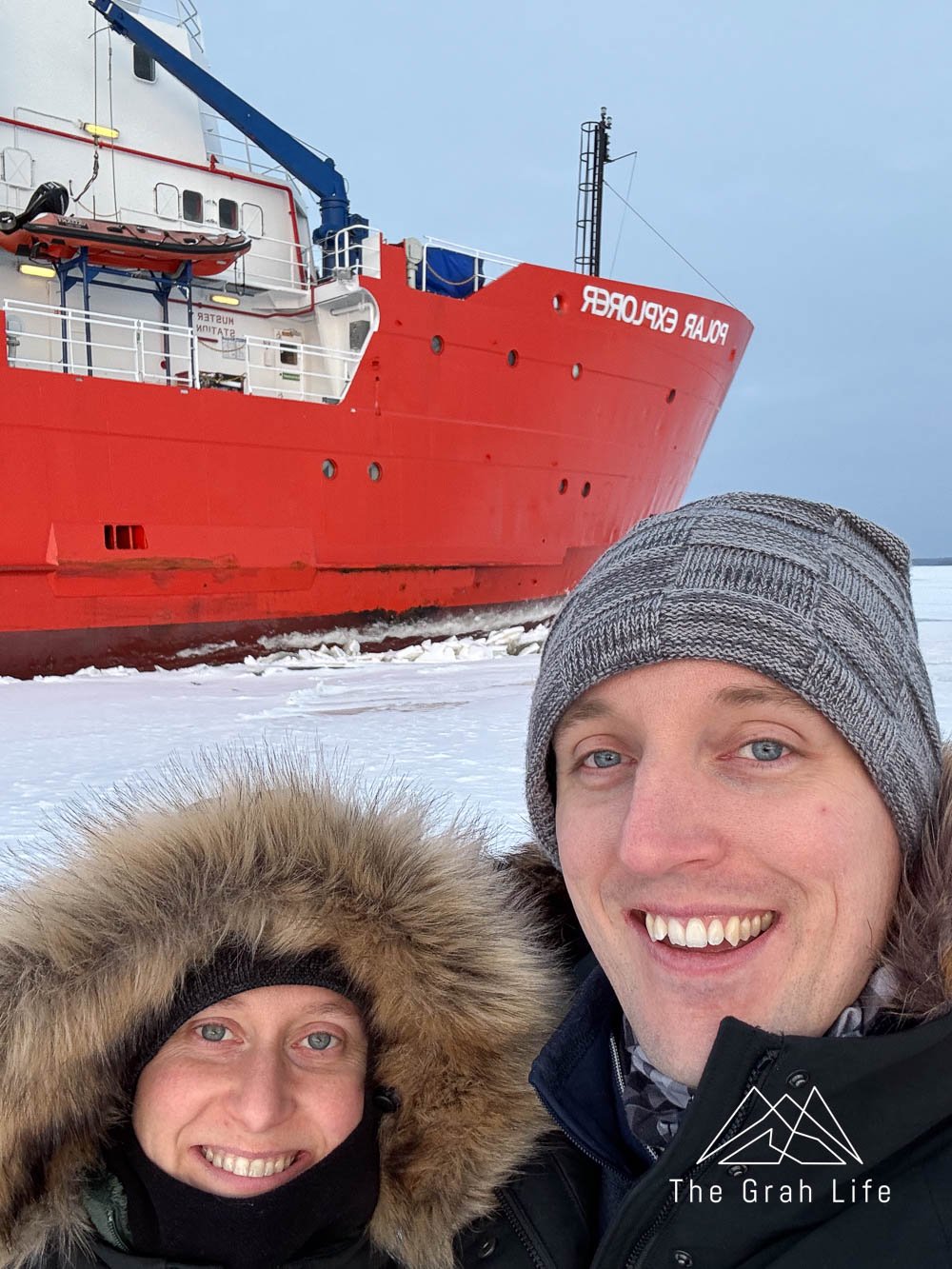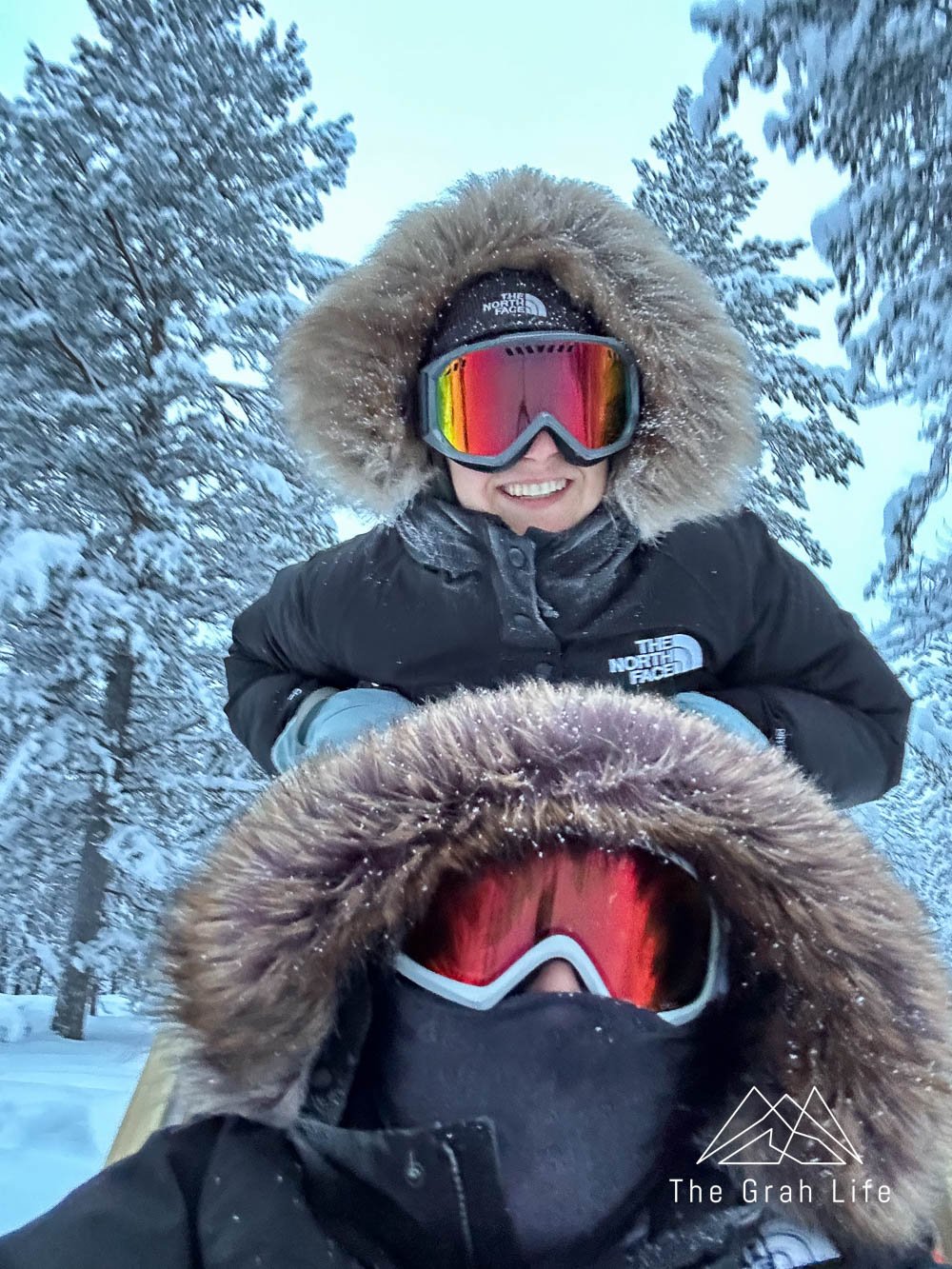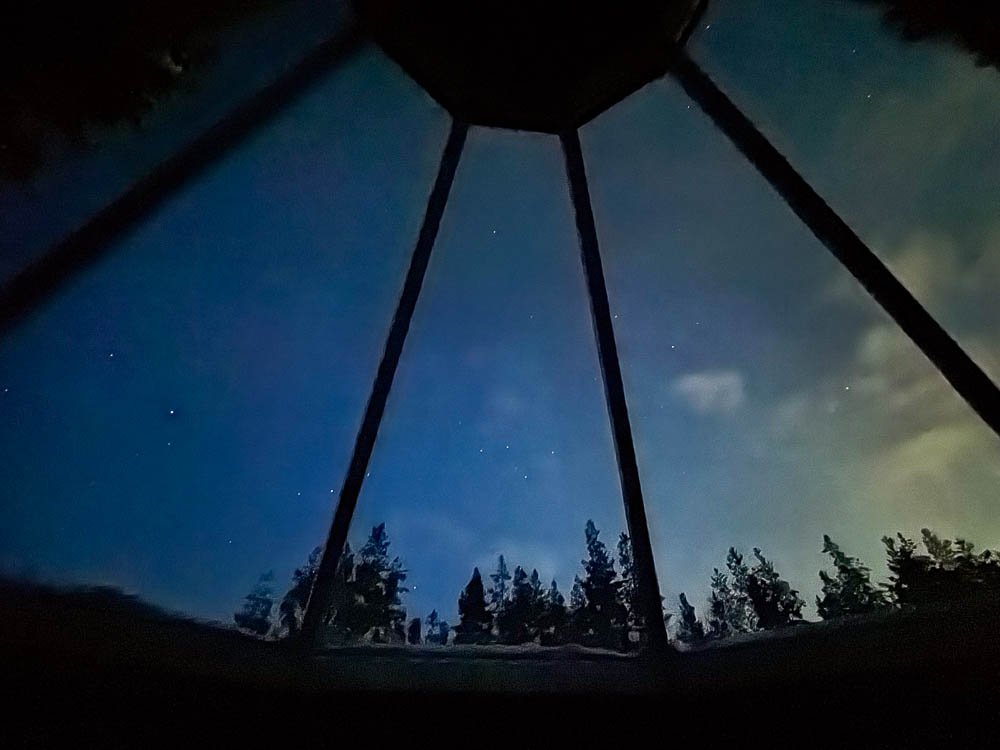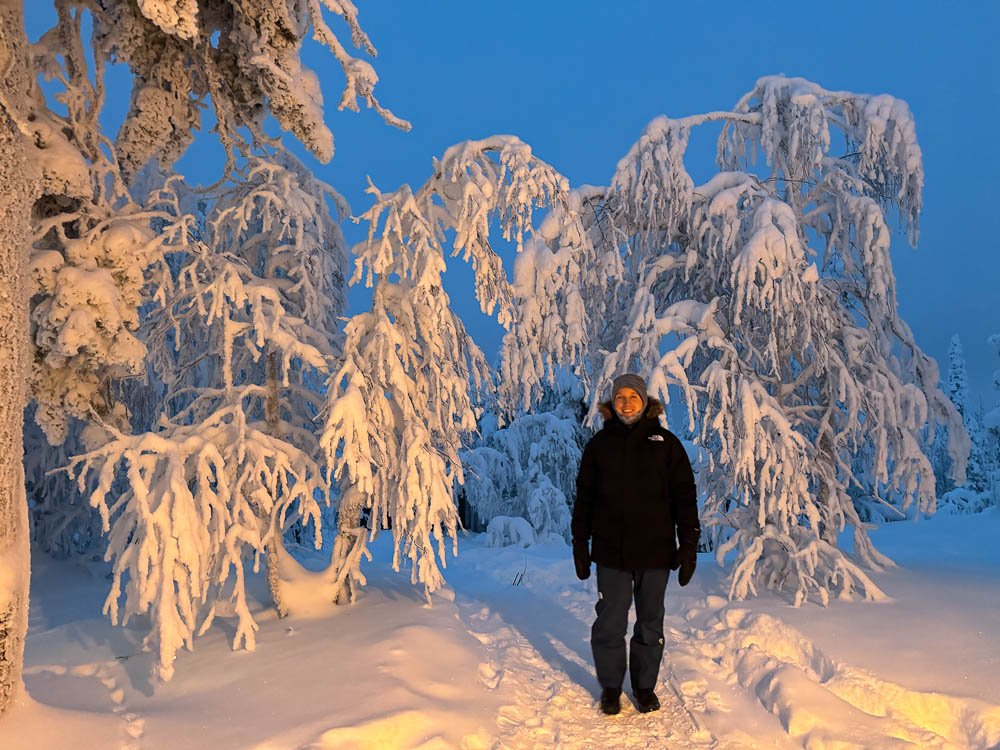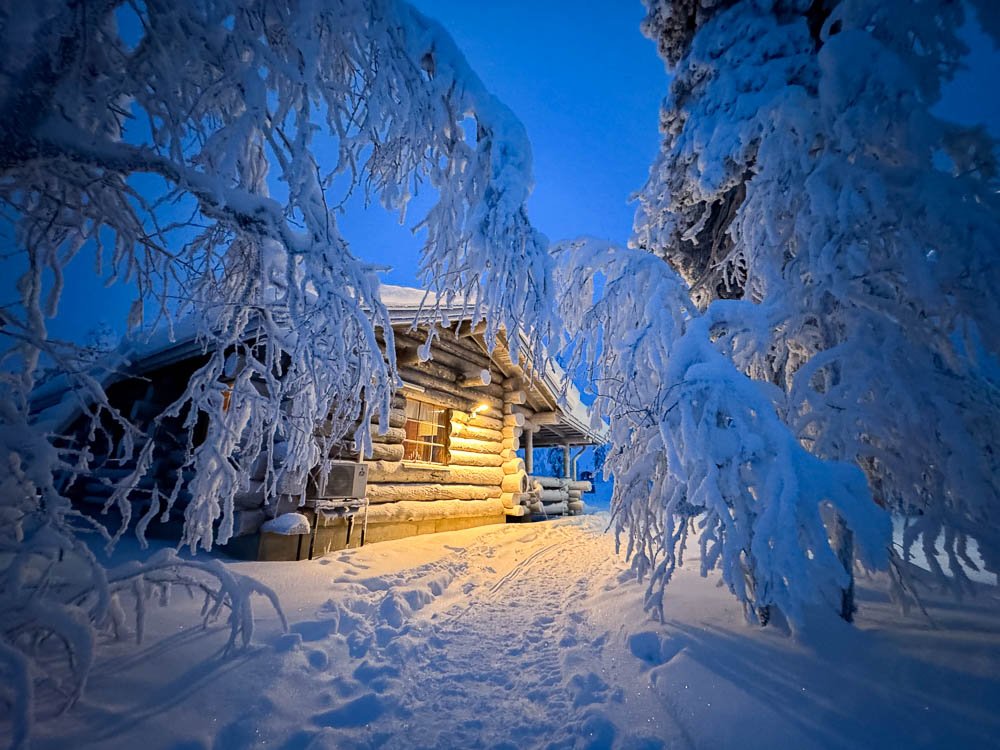Lapland Winter Packing List
Visiting Lapland is a bucket list trip, but the below-freezing temperatures are intimidating to pack for! In fact, this trip was so far outside our comfort zone that we wrote an entire blog on everything we feared and how we fared. You can rest assured every item on this packing list was combed through, debated, and tested before, and during, our trip.
Below you’ll find gear and clothing recommendations, along with tips on how to stay warm, and what to look for in your purchases.
If you’re looking for how to spend your time in Lapland, check out our itinerary here.
Clothing
Layering clothing is essential for staying warm in cold temperatures. With Lapland’s frigid wind, it’s vital.
How does layering work to keep you warm? Each layer of clothing traps and warms air between it and the next. Each layer of air is a layer of insulation.
After you purchase (or while trying on clothing in-store), try on your layers together. None of the layers should fit too tightly. Make sure they fit comfortably together, allowing for regular movement.
Base layers
Also referred to as thermal layers, base layers help retain heat and wick moisture. You’ll need base layers for both your top and bottom.
Hiking pant
You’ll wear hiking pants atop your base layer on the bottom. Why not jeans or other pants? Hiking pants dry quickly (unlike cotton), so if they do get wet, you won’t be cold for long.
Mid-layer tops
We wore our usual hiking mid-layers as our secondary layer on top.
Insulating layer
Atop your first two layers, you’ll wear an insulating layer like one of these fleece zip-ups.
We took off our parkas indoors, but kept everything else on.
Snow pants
You’ll have two options for ski pants — buying pants that are waterproof and insulated or pants that are just a waterproof shell.
Zach opted for a bib-style snow pant shell. Meghann is always much colder, so she went with insulated snow pants. Either will work to keep you dry.
Parka
You’ll layer a parka on top of all of that! This is a heavier, longer coat than a ski jacket. Do not skimp on this!
Look for parkas that go down past your waist, are waterproof, windproof, and insulated, with hoods like these.
We loved that our hoods had fur lining them. The fur had a wire frame so it was adjustable and it cut down the amount of wind that reached our faces significantly.
Windproof hat
It’s the wind chill that makes Finland feel cold. Wearing a windproof hat is a must. We found hats that are lined with fleece worked well.
We purposely avoided purchasing hats that had pom poms on the top so they’d fit under our parka hoods better. We were happy we did, too because wearing our hoods kept us warm and outside enjoying activities much longer.
Windproof buff
You’ll also want your neck to be protected from the wind. A fleece-lined buff will do the trick. We thought buffs worked better than thick scarfs because we could easily zip up our coats and put our hoods on when wearing them. These are absolutely necessary if you’re going dogsledding or tobogganing.
Meghann driving the dogsled
Mittens
Buy mittens rather than gloves — mittens keep your hands warmer. You’ll want a waterproof and insulated pair like these. These are comparable to what skiers wear. You’ll want to have a bit of extra space in them to fit glove liners in them, too.
Glove liners
Any glove that fits inside your mitten will work as a liner to give your hands a bit of extra insulation.
Boots
If you’re worried about your feet getting cold, you’ll want insulated snow boots. Look for boots with thicker soles that are waterproof and insulated. Purchase one size larger than you regularly wear so you can double or triple up socks as needed.
Zach wasn’t worried about getting cold feet, so he wore his usual waterproof hiking boots. This worked well for him, but Meghann was glad to have purchased snow boots.
Before the trip, we’d read a lot of blogs claiming Moon Boots were the best footwear option for Lapland. However, when we investigated, we found they had iffy reviews and shorter lifespans. They do look well insulated, but we doubt they’d be able to handle getting as wet as typical snow boots could.
No matter what boots you end up bringing, make sure they have great traction. You’ll be walking on snow and ice the entire trip! If necessary, you can add traction devices to your boots but prioritize finding boots with great traction.
Meghann’s thicker snowboots
Zach’s waterproof hiking boots
Wool socks
Wool socks are essential because wool traps and stores heat better than other fabrics. Purchase multiple pairs of these heavyweight socks.
Sock liners
If you’re looking to double or triple up your socks, pack a pair of sock liners. You can use them on other backpacking trips to help prevent blisters, but their use here is to control moisture. If your feet get sweaty, they’ll get cold when you stop moving. These sock liners prevent that.
Sock liners are also thinner than other socks, so Zach was able to squeeze these in with a pair of hiking socks into his regular hiking boots. Meghann was able to wear three pairs of socks in her snow boots with these. Since we only purchased one pair each, we saved wearing these for our coldest excursions.
Wool undergarments
Although these aren’t necessary (any undergarments will do) they are nice to have. Wool underwear and wool sports bras are odor-resistant and temperature-regulating. That means you’ll feel fresh for longer.
Sauna wear
Some touristy saunas require bathing suits and sandals, while others don’t. However, Finns tend to sauna naked, or with a towel wrapped around them.
We’d never used a sauna before visiting Finland but ended up loving them! Bring a suit and sandals so you can sauna as often as you like. There are an estimated 3.3 million saunas in Finland, so you’ll likely find one everywhere you visit.
Check out this blog for what to know about sauna basics.
Jeans
Helsinki wasn’t as cold as Lapland, so during our time in the city there were days we wore base layers with jeans instead of our usual mid-layer/hiking pant/snow pant combo. They’re a great item to pack if you’re hoping to enjoy the nightlife, but we were also thankful that we never felt out of place wearing snow pants in the city as well.
Make sure your base layers fit under the jeans you pack too
Pajamas
Bring a cozy set of PJs just in case your lodging is chillier than you expect. The large windows in the glass dome hotels do feel colder than normal hotel rooms, although we never had a problem heating them.
Hygiene
Lotion
You’re going to want lots of lotion. The cold, dry atmosphere will dry your skin out very quickly causing it to crack and bleed if left unattended. Put regular lotion everywhere, and thicker lotion on your hands at least once per day. Do this every day and you shouldn’t have a problem with your hands drying out, but do not wait for them to start cracking to begin applying. Avoid lotions with vaseline.
Facial moisturizer
Your face will dry out too! Put moisturizer on your face every day (at least 45 minutes in advance) before going out to help protect it. This is especially important on days you’ll be doing windy activities like dog sledding, icebreaker tours, skiing, or tobogganing.
Lip balm
You’ll go through lip balm just as much as you will lotion. Aquaphor, would work just as well.
We recommend keeping one lip balm on your nightstand and another in a coat pocket. You’ll be reapplying multiple times per day.
Facial sunscreen
The snow-covered ground reflects the sun so it’s a good idea to bring sunscreen.
Sunglasses
Again, the snow can make the landscape feel very bright. Pack a pair of sunglasses with you to drive safely.
Ski goggles
We wore these while dogsledding and tobogganing, and they made both experiences so much more enjoyable! Plus, they double as sunglasses.
Balaclava
Often called a snood, the balaclava was essential for enjoying tobogganing and other windy activities. Meghann wore her hat and buff underneath with the balaclava on top. Zach was jealous he didn’t have one!
Personal hygiene items
Don’t forget your usual personal items such as toothbrushes, personal medications, and the like.
Electronics
Travel adapter
You’ll need a travel adapter to charge devices throughout your stay. This one can be used for trips all around the world.
Night train
If you’ll be riding the night train to Rovaniemi, you’ll want to pack an eye mask and earplugs. The eye mask is essential because there is a small, but bright, LED light by the outlets next to the pillow area in the sleeping cabs. The earplugs are essential because the train walls are thin. Even with earplugs in, you’ll likely hear your neighbors as they get ready to deboard throughout the ride.
Paperwork
Passport
You’ll need a passport to enter Finland. Check with your country’s embassy to learn if you need to request a VISA before visiting.
Itinerary
This was the longest vacation we’ve taken yet. With that came many hotels and tours. You’ll want to keep track of confirmation numbers, tour dates/times, and amounts paid/owed all in one place.
We went as far as to record hotel breakfast times as well as extra tour information like the meeting location and check-in time if it was different than the start time.
We referred to our itinerary nearly every day, and it saved us so much time and hassle!
How to pack your gear
One question we felt ridiculous asking was how to pack a parka. The answer is — you don’t. Unfortunately, they’re large and bulky enough that you must wear them onto the plane rather than packing them. Use it as a blanket throughout your flight or pack it in the overhead bin IF there is extra room.
The same goes for your boots. Whatever boots you choose to bring to Finland will be bulky enough to need to be worn onto the plane rather than packed.
What to pack in your carry-on
You’ll want to prioritize space in your carry-on for items you may need upon landing. We chose to make hats, mittens, insulating gloves, buffs, and snow pants easily accessible.
What we chose not to pack
Hand and feet warmers
Gasp! We know. It’s shocking but after reading reviews from guides in Finland, we learned that they’re not very helpful. Other travelers swore by them, and we figured we could always purchase them in Finland if we regretted our decision. We never thought about them throughout our trip!
Portable charger
The cold weather drains batteries quickly. Instead of packing a portable charger, we packed a USB car charger since we had a rental car. Keeping our phones on airplane mode helped us save battery, and unless you’re planning on constantly using your phone, we don’t think a portable charger would be necessary.
Camera gear
We chose to leave our DSLRs and tripods (necessary to photograph the northern lights) at home to focus more on living in the moment. We’re happy with the memories we captured on our iPhones without having to worry about lugging around a large camera.
Remember that if you can’t find everything you need or if something doesn’t work as well as you hoped, you can always buy gear in Finland. There were plenty of shops sporting winter gear in each town.
If you’re wondering where to go and what to do during your visit to Lapland, check out our itinerary here.
Search the blog for more adventures! Try searching for topics such as “backpacking”, “waterfalls”, or “national parks”.

